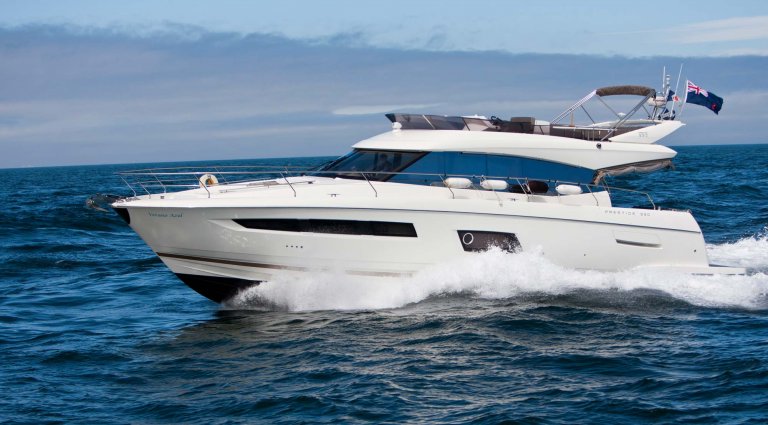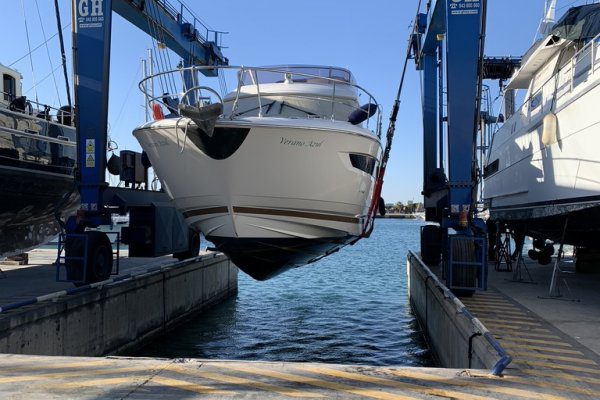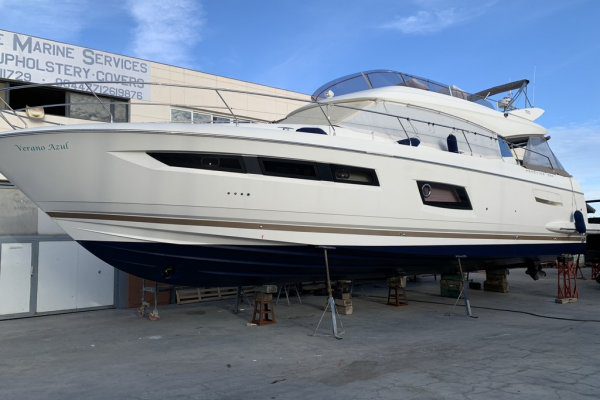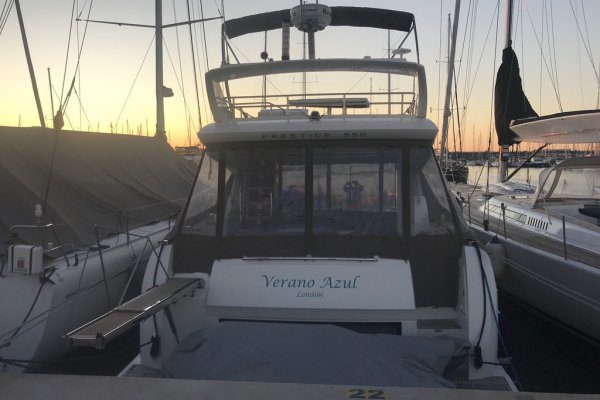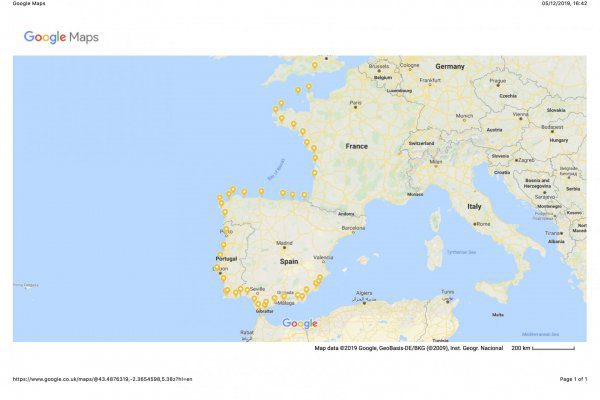Owner’s Adventure
Preparing for a grand tour on Verano Azul.
How we prepared our Prestige 550 for a multi-year trip to and around the whole Meditteranean.
In early 2015 we had the germ of an idea that as keen motor yachts people, qualified skippers and with grown up kids and retirement from work on the horizon we should take our boat to and around the Med (and possibly the Black Sea & Suez). We didn’t have a gap year when we were younger so this is our opportunity for our own adventure. Four years on we are ready to depart and this is the first part of our story – getting ready to go…
Buying a big enough boat
My husband quickly decided that our 43 ft Astondoa was neither big enough nor sufficiently spec’d for such a trip so at the September 2015 Southampton Boat show we bought our new Prestige 550 from the team at Ancasta. In March 2016 we took delivery of our dream and have spent the last 3 years mastering her with just the two of us as crew and getting her ready to go. Our planned departure is 20th March or first good weather day to take Verano Azul to Cherbourg and into Europe before Brexit !
What does our boat need to enable us to live comfortably for 6/7 months at a time?
Verano Azul was well spec’d for the Med but there are a number of things we have added to make our lives easier. Our kit list continues to grow but key investments to date include:-
Passerelle – a must for the Med and stern to mooring. Verano Azul didn’t have one on delivery so we post fitted it and now have a fabulous and very useful bridge and crane.
Tender and electric engine – we opted for a very clever Russian Rib style tender and a German electric outboard that stow nicely on the hydraulic bathing platform and are easily deployed from it.
Water maker – we don’t want to be in a marina every night on our trip. In fact, the less time we are in marinas, the better. So, anchoring is part of our plan, and the ability to make our own fresh water to replenish our boat’s enormous water tanks is important.
Wifi extender and internet Connectivity – to keep in touch with friends, family and the world.
Two foldable electric bikes – for easy exploration of the areas we visit. We have no time plan so expect to stay in places we like as long as we want and to move on only when we have seen all we want to see.
Inflatable paddle board and kayak – for exploring the coast, estuaries and Spanish rias.
Fishing gear – for all types of fishing – if we can mostly live off the sea then we will.
Spares and technical yacht management – we plan to be away for several years so need to have a full set of spares on board. We have also installed a Yacht Sentinel system to monitor power and batteries etc remotely.
Additional anchors – Verano Azul is a big boat so we upgraded the anchor and have added a couple of extra anchors for peace of mind
EPIRB, Life raft, life jackets, fire extinguishers, first aid kits (and up to date first aid at sea training) – everything has been serviced and up dated, we need to be prepared for anything.
When we depart from Royal Clarence Marina later this month for our first leg to Gibraltar (estimated arrival October 2019) we need to have everything heavy on board. Once we start we will be relying on flights back and forth and will have weight limits for what we can carry. Our plan is to buy and cook local produce, when in France we eat French, when in Spain… etc so we are not storing much food but have stocked up on staples like washing tablets, dishwasher tablets, loo rolls and kitchen roll etc – bulky things that are hard to carry on a bike. We also have a good stock of books, music (including a full sized keyboard), films, language courses and lots of things to entertain and educate us as we travel.
We will update our progress in the summer by when we expect to be somewhere on the North Spanish/Portuguese coast (who knows?).
Andrew & Emma Muir
Follow their story
Into the Med and beyond on board Verano Azul
We left you last in Northern Spain where we were enjoying the beautiful Rias of the North West Coast – all very pretty. From here we continued down the coast arriving in Portugal in late July where we spent a few lovely days in Porto before heading further down. By now, dolphin sightings were a very regular occurrence with several pods spotted daily, which was fabulous.
The coastal scenery heading down into Portugal was pretty stunning with dramatic cliffs and wide estuaries, when we could see it - much of this coastline was shrouded in thick fog for the whole time we travelled southwards. In Cascais (our most westerly point on this journey), we spent four days, including a day trip to Lisbon on the train. At times the fog was so thick we could hardly see the other boats in the marina, and this was pretty much our experience of Portugal until we turned the corner at Cabo de Sao Vincente and round into the Algarve. Then, within minutes, the fog lifted, the sun shone through, and the sea smoothed to a lovely millpond, and it felt as though summer was finally upon us. This is pretty much the weather and sea conditions we then had all the way to our final stop.
From the Algarve, where we spent a couple of weeks seeing friends and enjoying some long-awaited sunshine, we headed eastwards back into Spain at Ayamonte (up the Guadiana River that divides the two countries). We didn’t know this coast of Spain at all but were wonderfully surprised by the amazing stretches of beautiful beaches all along, not to mention the delicious seafood. One particular surprise to us was the absolutely delicious tuna we had in Barbate after a particularly horrendous trip around the Cape of Trafalgar (really bad winds and seas – not our favourite conditions).
But let’s not forget the fantastic few days we spent in Puerto Sherry where we made trips to both Cadiz and Jerez, historic Spanish cities with so much to see and, of course, great sherry and food to taste. From Barbate we headed down to Gibraltar, a little bit of England and the gateway to the Med. A crazy place with an M&S amongst many other very British things, but incredible views of two continents and two oceans from the top of the rock and a good opportunity to fill up with tax-free fuel.
From here we actually did something we hadn’t planned at all which meant heading backwards a little from our route. We popped over to Tangiers in Morocco to a brand new, recently built marina. We did this because it was so close, it seemed a shame not to do it, and it added another country to this year’s travels. Let’s just say it was an interesting experience in bureaucracy and clever scams and not necessarily something we want to repeat. Three days was more than enough, and we headed back to the relative calm of the southern Spanish coast for our last section of this year’s trip.
By now it was September, but the weather continued to be perfect, so we pootled along the Costa del Sol and Costa Tropical around the Cabo de Gato and, after a couple of days in Almeria, found our most perfect anchorage of the trip in the national park just around the corner. A stunning bay with no development and the clearest warm waters (we could see the anchor 10 metres down), perfect for swimming and watching the amazing sea life (flying fish, pipefish and amazing coloured fish we can’t name). It was heaven.
Our time was starting to run out, though, for this year. We had promised to catch up with some friends in Garrucha, and we also needed to be in Cartagena by mid-October. So, over the last few weeks in October, we headed north with the goal to finish in Torrevieja, a safe place to leave Verano Azul for the winter and an easy place from which to fly in and out of Alicante.
2,250 nautical miles, 47 ports and anchorages and 7 countries later (UK, France, Guernsey, Spain, Portugal, Gibraltar, Morocco) we arrived at the endpoint for this year’s adventure. Verano Azul behaved impeccably for the whole trip, and we learned so much along the way, including our first stern-to moorings in Gibraltar and Southern Spain. It has been the most amazing six months, and we are already looking forward to next April when our adventure around the Med continues.
Follow their story
Preparing for our gap year part 2 Torrevieja and beyond
Last summer we took our Prestige 550 flybridge motor cruiser, Verano Azul, from her home port of Portsmouth to the Med via Northern France, Spain, Portugal and Morocco. Our last update was from our winter mooring in Marina de Salinas, Torrevieja, just south of Alicante, having completed 2250 nm.
We left Verano Azul closed up at Marina de Salinas at the end of October, and it turned out to be a great winter berthing solution. It was cost-effective - the marina offered an excellent deal for six months and almost half the price of our original choice of Denia - and well located - just 30 mins drive from Alicante airport with excellent bus links. We felt reasonably happy to leave our summer home there.
The first time we saw Verano Azul again was at the end of January 2020, when we returned to do the annual lift and service. In the past, when we were moored in the UK, we employed a Cummins engineer to undertake the service each year, and we used the Sealift in Haslar Marina for the clean and antifoul. Knowing that we had the Med trip planned, Andrew spent time over the last two years with Dave, our excellent engineer, learning the ropes to enable him to do the service himself while we were away. Copious notes and GoPro videos of the process were made so we could be self-sufficient once we left UK shores. We still needed a lift that could hold our now 30-ton boat and a good boatyard to do the clean and antifoul, but we couldn’t have been luckier because the boatyard at Marina de Salinas was highly professional and they spoke excellent English.
All was well on board when we arrived, apart from a bit of bump on the starboard side trim. Our neighbouring boat had clearly hit us hard while being moved. But they were no longer around, so we just had to deal with it. We had provisioned Verano Azul with most of the spares needed for three years of servicing ahead of leaving the UK but still managed to take two huge suitcases of tools and parts for Andrew to carry out the servicing. Andrew loves doing this kind of thing and was well prepared with a step-by-step checklist of jobs and Dave, our fabulous Cummins engineer in the UK, was on hand to take calls if needed.
The great thing about the Cummins engines and drives is that once you know the process and have acquired a couple of specialist tools, it is pretty straightforward to do the service yourself. The service took about two days to do and, other than a slight (understatement) oil spillage, all went pretty smoothly. Engine oil was pumped out, fuel and oil filters were changed, engine anodes replaced, impellers inspected, drives drained and pumped out and refilled and external anodes renewed. Andrew reckons that the next time it could all be done in a day.
Learnings from last year’s journey included: never depend on being at a specific place by a certain date (chill and go with the flow); invest in the absolute best toolset money can buy; have a complete set of spares and consumables on board; make sure you understand every system in your boat before you depart; having a good boat monitoring system brings great peace of mind and is an investment well worth making (we can remotely monitor four banks of batteries, temperatures, intrusion, bilge water, shore power failures and boat location); check every nut and bolt and fixture on your boat periodically (on such a long journey things can work loose and bits can drop off); expect the unexpected!
So now we are in really good shape to set off again in April and are getting excited about this year’s plans. Our flights to Alicante are booked for mid-April, and all we need to do on arrival is open up the boat, give her a very deep clean to remove the winter dust and sand, spruce up the teak and load up with stocks. Our outline plan for this year is to head out to the Balearics before they get busy, back along the Costa Brava, South of France, North Italy, across to Corsica and Sardinia, back to Italy and down to Sicily; another 2500-ish nautical miles to cover over six months to the end of October.
